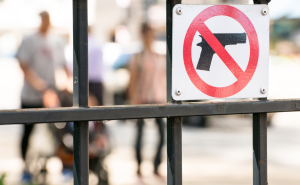Supreme Court Upholds Domestic Violence Gun Ban: Implications for the Second Amendment and Survivors of Domestic Violence

In United States v. Rahimi, the U.S. Supreme Court in an 8-1 decision upheld a federal statute prohibiting individuals subject to domestic violence protective orders (DVPOs) from possessing firearms. The case had significant implications for gun safety regulations and the protection of domestic violence survivors who we know are at greater risk of injury and death from armed abusers.
“This decision is a crucial first step in continuing to safeguard the lives of domestic violence survivors and public health at-large. It reaffirms policymakers’ ability to impose necessary restrictions on gun possession for those who pose a danger,” says Kelly Roskam, JD, law and policy director of the Johns Hopkins Center for Gun Violence Solutions.
While many domestic violence survivors, victims, and advocates are relieved with the Supreme Court’s ruling, the Court’s continued reliance on a murky, history-focused test leaves the door open for future challenges to firearm safety policies according to the Center's experts.
Case Background
The case centered around Zackey Rahimi, who was indicted for possessing a firearm while under a DVPO. In 2019, Rahimi assaulted his girlfriend and the mother of his child—identified as C.M. in court documents— in a parking lot in Arlington, Texas. He also threatened to shoot her if she told anyone what had happened. C.M. sought a DVPO, recounting the assault in the parking lot as well as other assaults and threats. The court, with the consent of Rahimi and C.M., entered a DVPO against Rahimi finding that he was a credible threat to the physical safety of C.M. and their child. Rahimi was found in possession of firearms, which is in violation of federal law and indicted. Rahimi challenged the indictment, arguing that the prohibition violated his Second Amendment rights. The district court denied his motion, but following the Supreme Court’s decision in New York State Rifle & Pistol Association, Inc. v. Bruen, the Fifth Circuit Court of Appeals reversed the district court’s ruling. In Bruen, the Supreme Court articulated a new test for evaluating Second Amendment cases which requires the government to show that the modern law is sufficiently analogous to historical firearms laws. The Fifth Circuit, through a stringent application of Bruen, held that the federal law under which Rahimi had been indicted violated the Second Amendment because the court could discern no analogous historical tradition to support its constitutionality.
The Decision
Chief Justice Roberts, delivering the majority opinion of the Court, stated that temporary disarmament when an individual has been found by a court to pose a credible threat to the physical safety of another is consistent with the Second Amendment. The Court ruled that the federal law prohibiting possession of firearms by persons subject to DVPOs fits within the historical tradition of firearm regulation, aligning with principles dating back to the founding era. This is the first time the court has applied the historical test created in their 2022 Bruen decision.
“Though the Court’s ruling makes clear that Bruen’s history-driven test is still the controlling framework for assessing Second Amendment cases going forward, the Court’s application of Bruen in this case does provide some flexibility to the historical approach and cautions against courts applying Bruen too narrowly in Second Amendment challenges to other gun safety laws,” says Kari Still, JD, law and policy advisor at the Center.
The Court's decision reemphasized that the Second Amendment is not unlimited and identified a historical principle that individuals posing a threat can be disarmed consistent with the Second Amendment. The ruling also clarified that modern regulations need not be identical to historical laws but should be relevantly similar in purpose and application.
Meanwhile, Justice Clarence Thomas, who authored the Court’s Bruen opinion, rejected the majority’s assertion that the country has a historical tradition of disarming dangerous individuals. He searched for a historical twin and claimed “not a single historical regulation justifies the statute at issue.” His lone dissent highlighted the divergence over the application of Bruen’s history-focused test that he helped create.
“The majority decision in Rahimi marks the beginning, not the end, of managing the damage to Constitutional law and public safety wrought by Bruen. The court was careful to keep its decision narrow, leaving many contentious questions open for lower courts to face with minimal guidance,” says Tim Carey, JD, law and policy advisor at the Center.
In the wake of the Rahimi decision, the Justice Department has requested additional clarity from the Court in five other pending Second Amendment cases.
Implications for Survivors of Domestic Violence
The decision has significant implications for survivors of domestic violence. By upholding federal law, the Court has reinforced the legal framework that protects survivors from armed abusers. This ruling ensures that individuals deemed a credible threat by the courts cannot possess firearms, potentially preventing further violence.
The research is clear that these policies work to protect public health. One study from experts at the Center found that DVPO firearm prohibitions are associated with significant reductions in intimate partner violence. These orders also impact the safety of the general public. The Center's researchers found 68% of mass shooters from 2014-2019 either killed family or intimate partners or had a history of domestic violence.
“Every survivor of partner violence in the U.S. has been anxiously awaiting this decision,” Lisette Johnson, a survivor of domestic violence from Virginia, told the Center via email. “This is a step in the right direction to make sure other women and their children don't have to go through the lifelong trauma my children and I have after my husband shot me and took his life just feet away from them.”
Years of evidence shows that a domestic abuser’s access to firearms is one of the most significant risk factors for domestic violence turning deadly. An abused woman is five times more likely to be killed by a male partner when there is a firearm in the house.
“By affirming the disarmament of individuals who pose a threat of violence, this protects public health, reducing the risk of firearm-related injuries and deaths among our most vulnerable populations,” says Alex McCourt, JD, PhD ’19, MPH, core faculty of the Center. “While we’re pleased with the Court’s decision, more must be done to disarm domestic abusers and protect victims.”
Conclusion
The Supreme Court’s decision in United States v. Rahimi is a significant affirmation of the constitutionality of disarming individuals who pose a threat to others, particularly in the context of domestic violence. By instructing courts to rely on the principles underpinning historical firearms laws, rather than demanding the government identify historical “twins,” the Court has started to clarify how history justifies policies today that address the uniquely modern crisis of gun violence.
For more in-depth discussion of United States v. Rahimi and its implications for the future of gun violence prevention laws, tune in to the forthcoming episode of Sufficiently Analogous.




